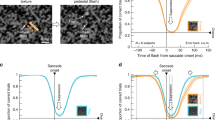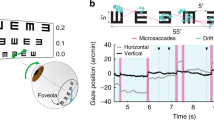Abstract
SACCADIC (jumping) eye movements are the characteristic way of moving the eye from point to point. The eye rarely moves in any other way except during tracking. A crucial fact, established definitively by Riggs's1 and Ditch-burn's2 groups, is that the eye continues to make small saccadic movements of about 2–10 min of arc as it fixates a point. Fig. 1 shows how the horizontal component of these eye movements resembles the discontinuous step-function of an electronic square wave. When a saccade occurs, the retinal image abruptly shifts on the retina by an angle equal to the angle of the movement. This simple fact is used here as the basis for a model of the transmission in the human visual system of information about the edges of objects. This fact alone can logically sustain the model, although other evidence will also be presented.
This is a preview of subscription content, access via your institution
Access options
Subscribe to this journal
Receive 51 print issues and online access
$199.00 per year
only $3.90 per issue
Buy this article
- Purchase on Springer Link
- Instant access to full article PDF
Prices may be subject to local taxes which are calculated during checkout
Similar content being viewed by others
References
Riggs, L. A., Armington, J. C., and Ratliff, F., J. Opt. Soc. Amer., 44, 315 (1954).
Ditchburn, R. W., and Ginsborg, B. L., Nature, 170, 36 (1952).
Young, L. R., and Stark, L., Inst. Rod. Eng. Trans. HFE-4, 38 (1963).
Gaarder, K., Koresko, R., and Kropfl, W., EEG Clin. Neurophysiol. (in the press).
Gaarder, K., Science, 132, 471–472 (1960); Brit. J. Physiol. Optics (in the press). Steinman, R., J. Opt. Soc. Amer., 55, 1158–1165 (1965).
Gaarder, K., Krauskopf, J., Graf, V., Kropfl, W., and Armington, J. C., Science, 146, 1481 (1964).
Krauskopf, J., J. Opt. Soc. Amer., 53, 741–744 (1963).
McCollough, C., Science, 149, 1115 (1965).
Ashby, W. R., Design for a Brain, second ed. (Wiley, New York, 1960).
Author information
Authors and Affiliations
Rights and permissions
About this article
Cite this article
GAARDER, K. Transmission of Edge Information in the Human Visual System. Nature 212, 321–323 (1966). https://doi.org/10.1038/212321a0
Issue Date:
DOI: https://doi.org/10.1038/212321a0
Comments
By submitting a comment you agree to abide by our Terms and Community Guidelines. If you find something abusive or that does not comply with our terms or guidelines please flag it as inappropriate.



